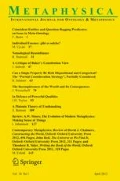Abstract
In this paper, I argue that both perdurance theory and the ‘relations-to-times’ endurantist view rely on an atemporal notion of property instantiation and relation bearing. I distinguish two possible meanings of ‘atemporal’ which result in two different understandings of what it is for an object to have a property or to bear a relation atemporally. I show that standard presentations of the theories considered are indeterminate as to which of these two understandings is the intended one. I claim that even if both understandings are admissible, one of them is more attractive and has more to recommend than the other.
Similar content being viewed by others
Notes
Sider (2001), p. 56. Here and elsewhere I have replaced ‘perdurantists’ by ‘fourdimensionalists’. This replacement is harmless in the present context, even if fourdimensionalism as defined by Sider is not in general equivalent to perdurantism as defined here.
Hawley (2001), pp. 17, 24. It is worth mentioning that Hawley herself does not subscribe the RTT view.
Sider (2001), p. 56.
Hawley (2001), p. 16.
A slightly more sophisticated version of this argument is advanced by Rodríguez-Pereyra (2003).
Sider (2001), p. 59.
“Throughout much of this book I will happily speak of atemporal parthood. But when I am trying to convince my opponents that fourdimensionalism is intelligible I had better not speak of atemporal parthood (...) Any argument for four-dimensionalism that uses ‘part of’ without temporal qualification in its premises faces the charge of begging the question since it is central to many versions of three-dimensionalism that ‘part of’ requires temporal qualification. So I will qualify the part-whole relation to times in my formulation of four-dimensionalism”. (p. 57).
Lewis (2002), p. 1. Similarly, some of his earlier (1986) remarks about the problem of temporary intrinsics suggest that for him the real issue is change by itself. He does not make this point explicitly with respect to change across time, but he does so in relation to the parallel problem in the modal case: “[the problem of accidental intrinsics] would not arise for Humphrey’s essential properties, however intrinsic. For the problem is how he can have different properties as part of different worlds, and in the case of essential properties there is no variation to worry about. It is very hard to see how Humphrey could be a man as part of one world and an angel as part of another, but if he is essentially human that difficulty does not arise”. (p. 201).
References
Hawley, Katherine 2001. How Things Persist. (Oxford: Oxford University Press).
Lewis, David 1986. On the Plurality of Worlds. (Oxford: Blackwell).
Lewis, David. 2002. “Tensing the Copula”, Mind 111: 1–13.
Rodríguez-Pereyra, Gonzalo (2003). ‘What is wrong with the relational theory of change?’ in H. Lillehammer and G. Rodriguez-Pereyra, eds., Real Metaphysics, (Routledge): 184–195.
Sider, Theodore 2001. Four-Dimensionalism: An Ontology of Persistence and Time. (Oxford: Clarendon).
Acknowledgements
I would like to thank the following people for their helpful comments and criticism to previous versions of this paper: Marta Campdelacreu, Fabrice Correia, Dan López de Sa, Manuel García-Carpintero, Ben Caplan, María José Alcaraz, Dave Horacek, and Fabio del Prete. Research leading to this paper was partially funded by the DGI of the Spanish Government, project HUM2004-05609-C02-01.
Author information
Authors and Affiliations
Corresponding author
About this article
Cite this article
Rychter, P. Perdurance, Endurance, and ‘Having a Property Atemporally’. Int Ontology Metaphysics 9, 159–171 (2008). https://doi.org/10.1007/s12133-008-0029-8
Received:
Accepted:
Published:
Issue Date:
DOI: https://doi.org/10.1007/s12133-008-0029-8


